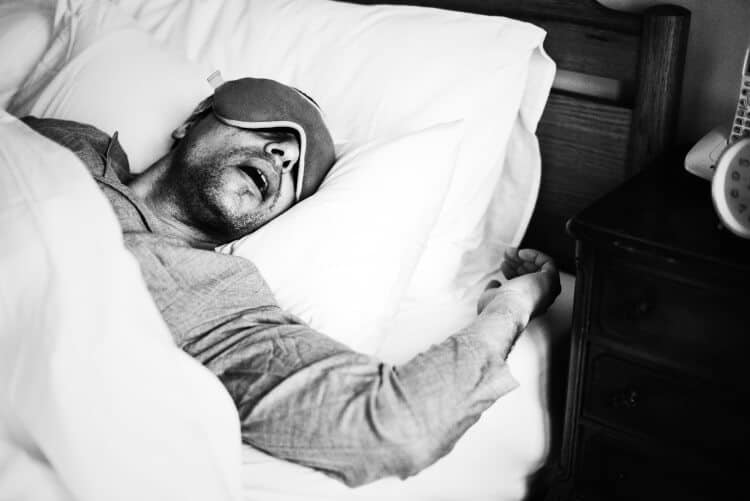Humans breathe through both their noses or mouth at some point. Usually, it is not a problem, though it is healthier to breathe through your nose. Sleeping with an open mouth, long term can cause serious health problems that require medical attention if your body is struggling for air.
Those prone to sleeping with an open mouth:
- People who are under chronic and high amounts of stress.
- Those with sinusitis, chronic allergies, asthma, a stuffy nose, a sinus infection, a lingering cold, or any congestion typically prevents comfortably breathing through the nose.
- Individuals with anatomical abnormalities, such as crooked nasal walls or an irregularly shaped face.
- Patients on certain medications might combat mouth breathing.
- Mouth breathing can also transpire through habit. Parents should observe children to help stop the practice early.
Sleep Apnea
Sleep apnea is a common, but potentially dangerous disorder where your breathing momentarily stops or growws shallow, repeatedly during sleep. This prevents your body from getting adequate oxygen and forces an open mouth to take in extra air. If you believe you could have sleep apnea please see your doctor for testing and treatment to ease your symptoms and prevent the development of further complications. There are two types:
Obstructive sleep apnea (OSA) is the more common type and occurs when the muscles in the back of your throat relax or the airway becomes blocked, narrowed, or closed as you inhale. Without receiving adequate amounts of air your brain senses the lack of oxygen and briefly wakes you from sleep so that you can breathe again, encumbering your ability to reach the deep, restful phases.
Central sleep apnea (CSA) is less common and occurs when your brain fails to transmit the proper signals to your respiratory muscles. You might awaken with shortness of breath or have a difficult time maintaining sleep.
Complex sleep apnea syndrome (or Treatment-emergent Central Sleep Apnea) is the condition where a patient has both OSA and CSA.
Risk factors
Sleep apnea can affect anyone, at any age, but certain influences heighten the risks for each type.
Obesity- excess weight that obstructs your upper airway to hamper breathing.
Genetics- Some people with thicker necks circumferences have narrower airways. Having family members with sleep apnea might multiply the possibility of developing apnea, Having large tonsils or adenoids can block breathing.
Gender- Men are more likely to have sleep apnea.
Age- As we grow older the chances of developing sleep apnea significantly increase.
Drugs- the use of alcohol, sedatives, or tranquilizers, that relax the muscles in your throat, and hinders airflow.
Smoking- Smokers are three times more likely to have obstructive sleep apnea, by increasing inflammation and fluid retention.
Nasal congestion- chronic difficulty breathing through your nose can develop into obstructive sleep apnea.
Medical conditions- Congestive heart failure, hormonal disorders, high blood pressure, Parkinson’s disease, Type 2 diabetes, stroke, Polycystic ovary syndrome, asthma, and other lung diseases can increase the risk.
Using narcotic pain medications- Opioid medications, especially long-acting ones such as methadone, increase the risk of central sleep apnea.
Risks of Untreated Sleep Apnea
Losing good quality sleep can result in serious medical conditions. Repeated wakening makes normal, restorative sleep impossible leading to hypersomnia, or excessive daytime exhaustion. You might also feel irritable, quick-tempered, moody, or depressed and struggle to make decisions, remember things, or control your behavior. You might find yourself falling asleep at work or at other inconvenient times. People with sleep apnea have an amplified risk of motor vehicle accidents. Children with sleep apnea often face performance obstacles in school and exhibit behavior problems.
Sudden drops in blood oxygen levels (hypoxia) increase blood pressure and puts a strain on the cardiovascular system. OSA increases the risk of hypertension, heart failure, and stroke. Multiple episodes can lead to sudden death. Having sleep apnea, also, increases your risk of developing insulin resistance type 2 diabetes. People with sleep apnea might be more likely to have issues with abnormal liver function and processing certain medications and general anesthesia. Major surgery is hazardous due to breathing problems when sedated and lying on their backs.
Loud snoring can also be a burden for anyone who sleeps near you. It’s common for a partner to have to go to another room to get far away enough, to get a decent sleep.
Diagnosis and treatment
Sleep apnea is usually diagnosed after your doctor checks your family history, reviews your medical background, and conducts a physical exam with a sleep study. If you meet the criteria, a specialist will discuss the best course of action, depending on the type, symptoms, duration, and any other concurrent health problems and considerations. More than one option may be necessary.
The most common treatment for improving your sleep and increasing your oxygen levels is positive airway pressure (PAP) treatment:
CPAP
Continuous Positive Airway Pressure treatment involves sending a fixed and constant stream of air into a sleeper’s airway to keep it from collapsing.
BiPAP
Bi-level Positive Airway Pressure machines have two pressure settings for exhalation and inhalation. Usually, it is not the first treatment option recommended by doctors, unless you have severe breathing problems
APAP
Automatic Positive Airway Pressure (Auto-adjusting technology allows for different pressure levels throughout the night. It automatically adapts to your breathing patterns and sets a most fitting pressure.
EPAP
Expiratory Positive Airway pressure places valves in the nostrils to create air pressure along with natural breathing to keep the airway open.
ASV
Adaptive Servo-Ventilation therapy is generally intended for people with CSA or a combination of OSA and CSA and provides air pressure levels that continually regulate a sleeper’s needs.
Non-PAP treatments and solutions
Oral devices like mouth guards, stabilize the jaw and mouth to support an open airway.
Surgery works best for people who have severe OSA, oversized Tonsils or adenoids, or atypical forms of the facial bones and skull bones. Medications are sometimes prescribed to increase respiratory functions. Lifestyle changes could, also, lessen your symptoms.
Contact a doctor to determine the cause of your problematic sleeping habits. They should collect a series of details including family history, medical background, and daily routine. A diagnosis should be established after a sequence of tests.
Sleeping with a tilted head position can prevent nasal congestion and open the airways, so add a pillow or two for a boost. It is advised not to sleep on your back, as the tongue can obscure airflow
Exercise and weight loss can help improve blood pressure, up your energy, and diminish your risk of developing diabetes and heart disease. Yoga is an excellent option to learn breathing control and aerobic exercise can also help strengthen the heart and lungs. Learn breathing techniques. Sleeping with your mouth open for extended periods will make the muscles of the mouth and face nonfunctioning and fatigued, so it’s important to work out the respiratory system.
Limiting alcohol consumption can alleviate sleep apnea. Quit smoking to reduce irritation and swelling of the airway. Smoking leads to long-term lung and breathing difficulties. Avoid certain medications that worsen sleep apnea, like Benzodiazepines.
Asthma and exposure to allergens can cause nasal congestion which can force an open mouth during sleep. Clear your space of dust, dander, mites, and any allergens that trigger respiratory reactions. Try home remedies to improve nasal breathing like warm tea, a steam bath, nasal sprays, and spreaders, before bedtime.







